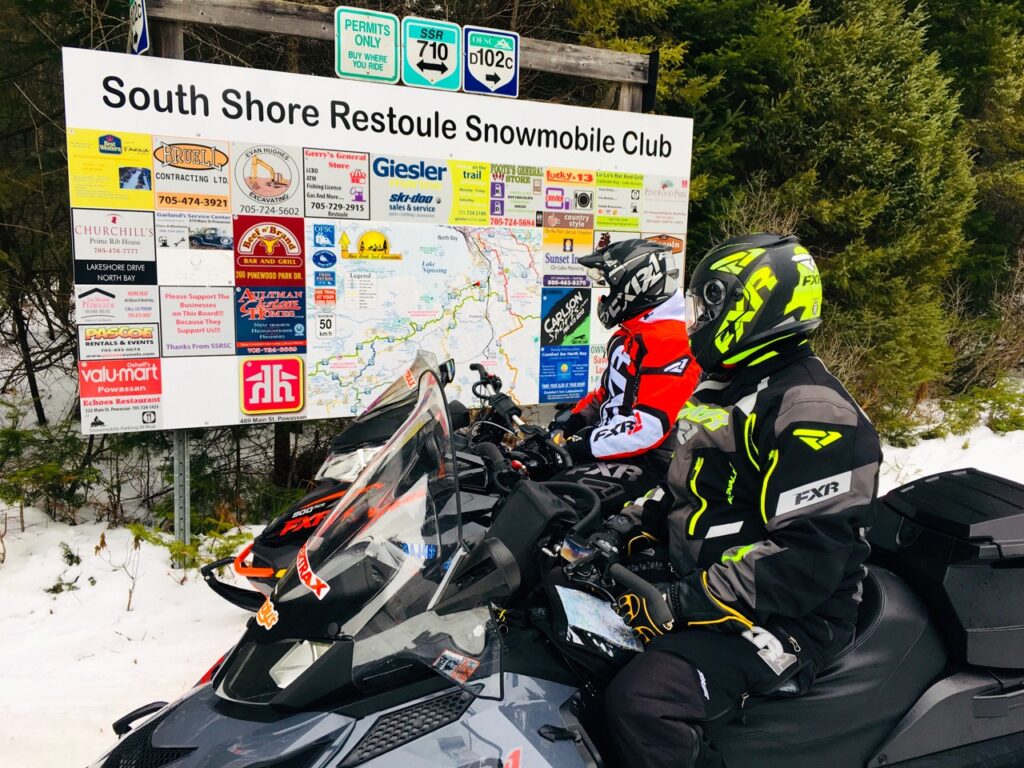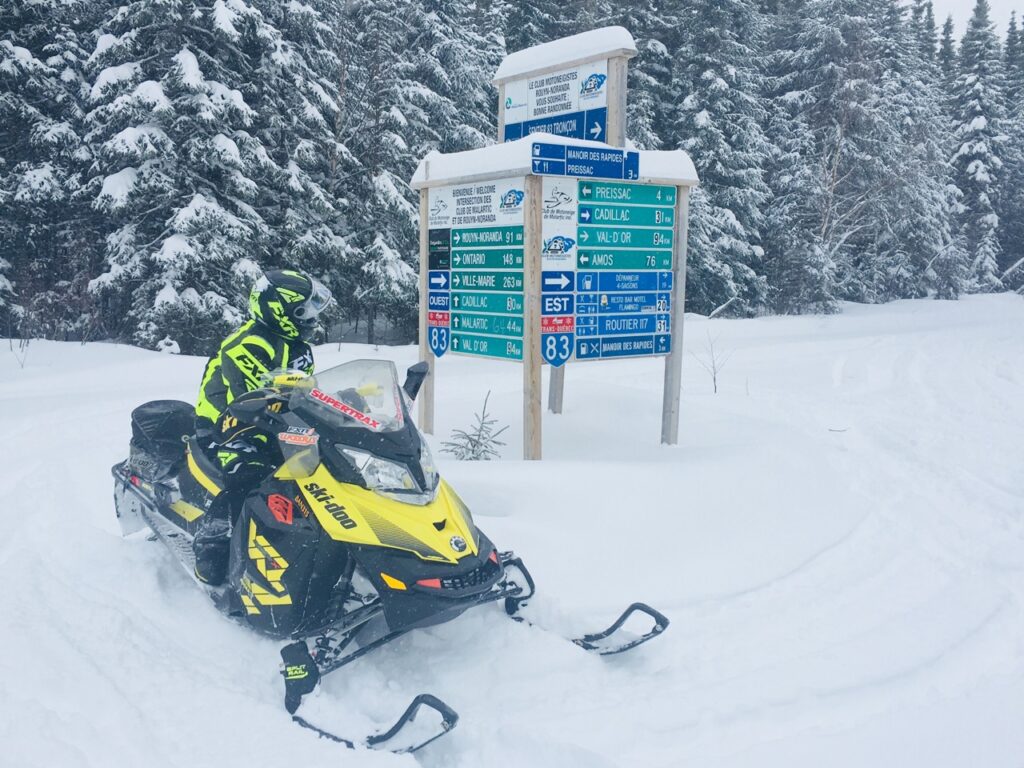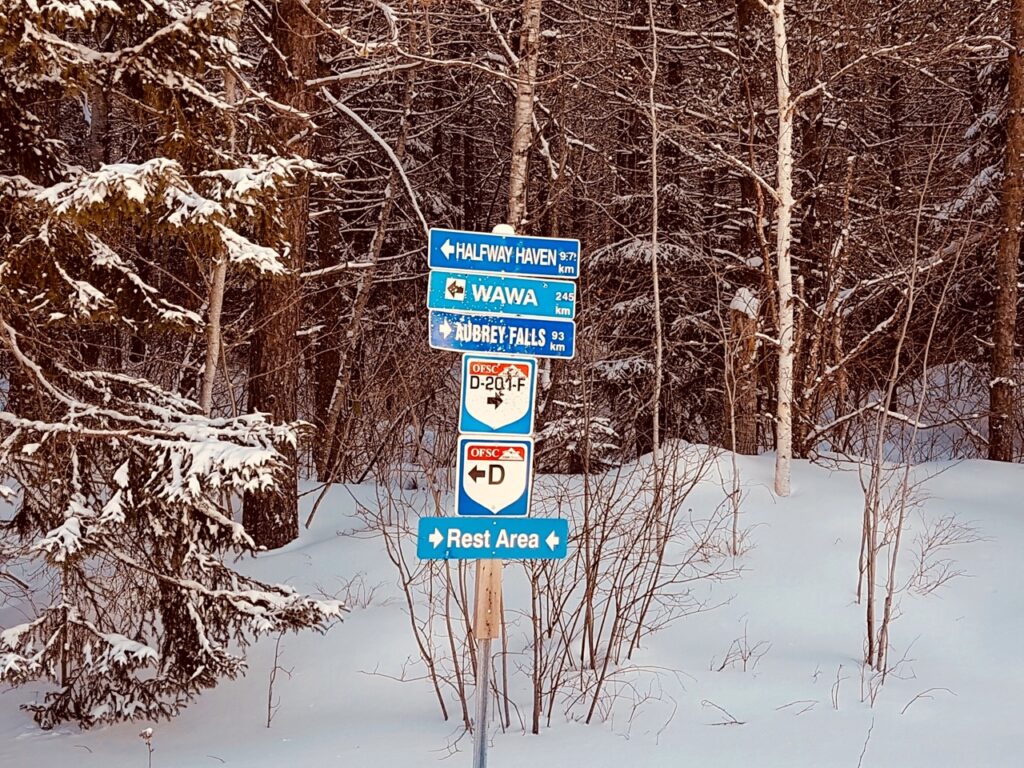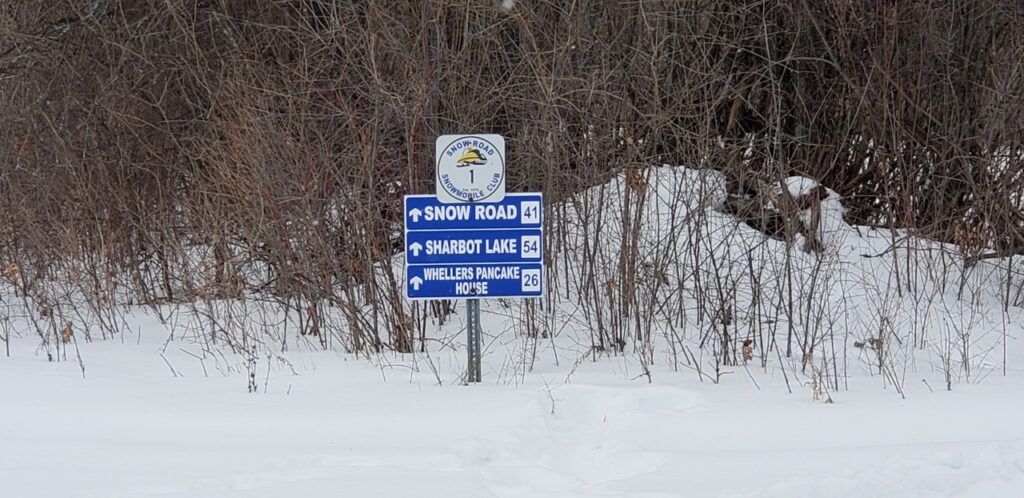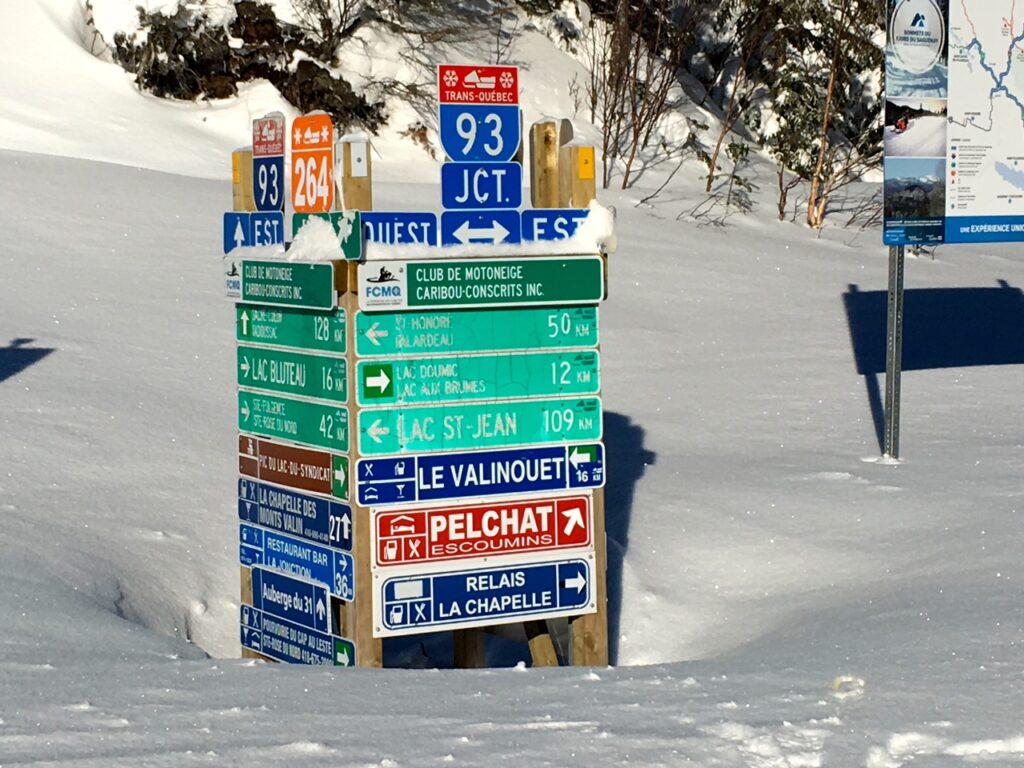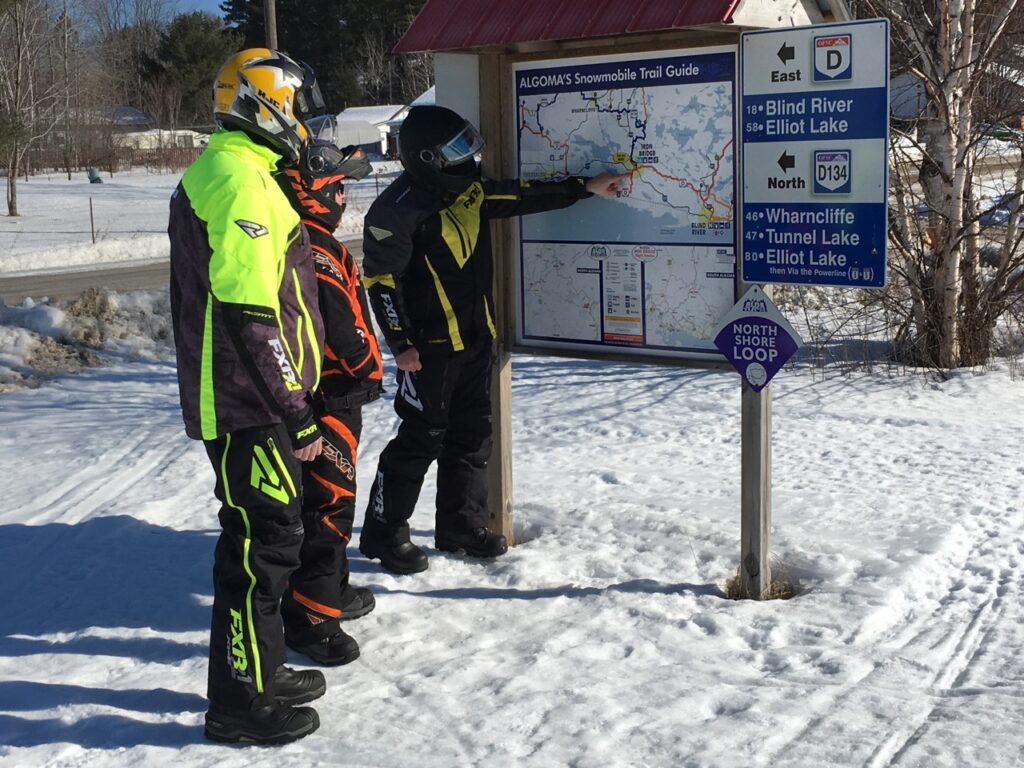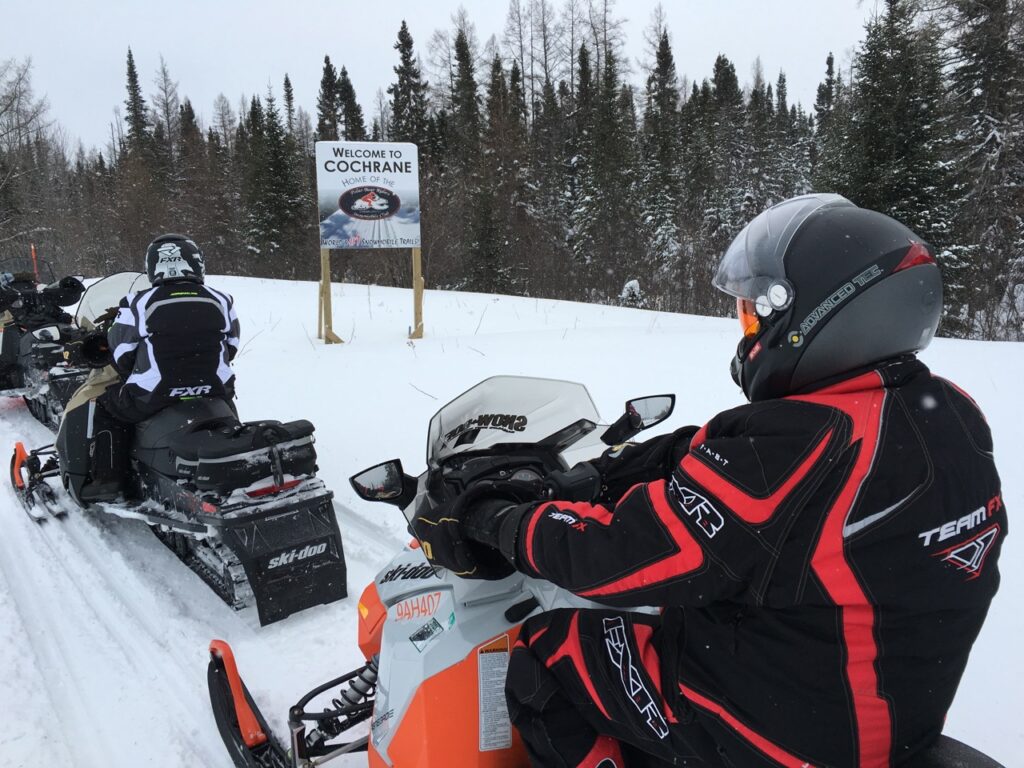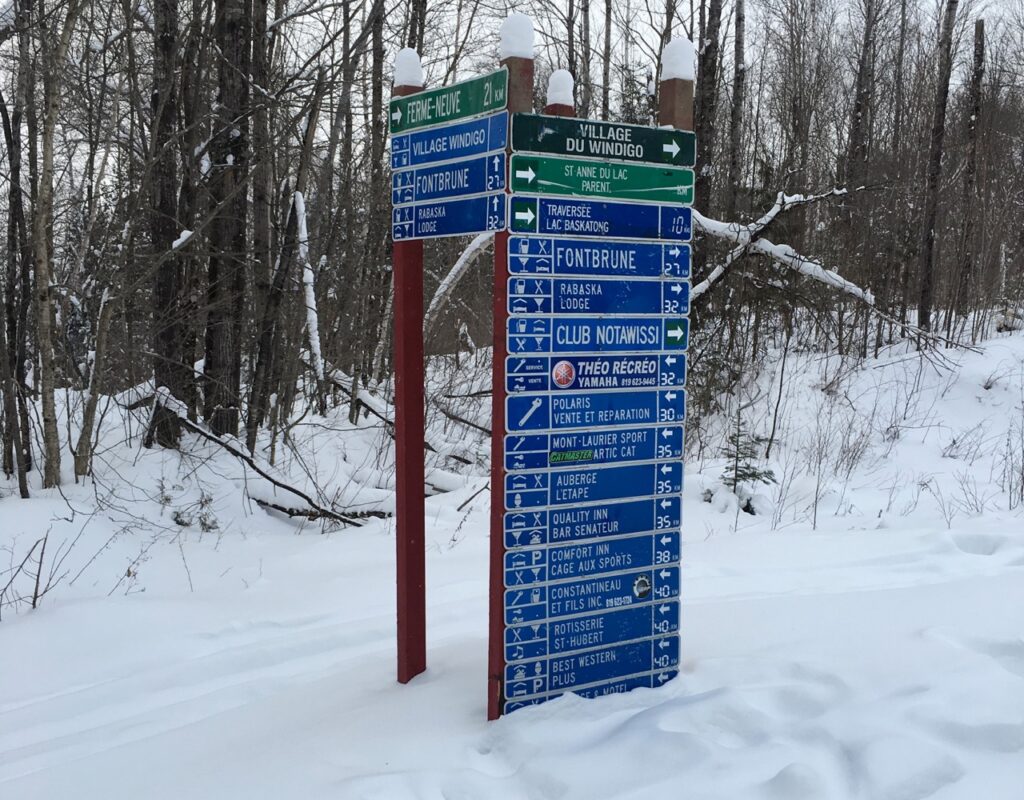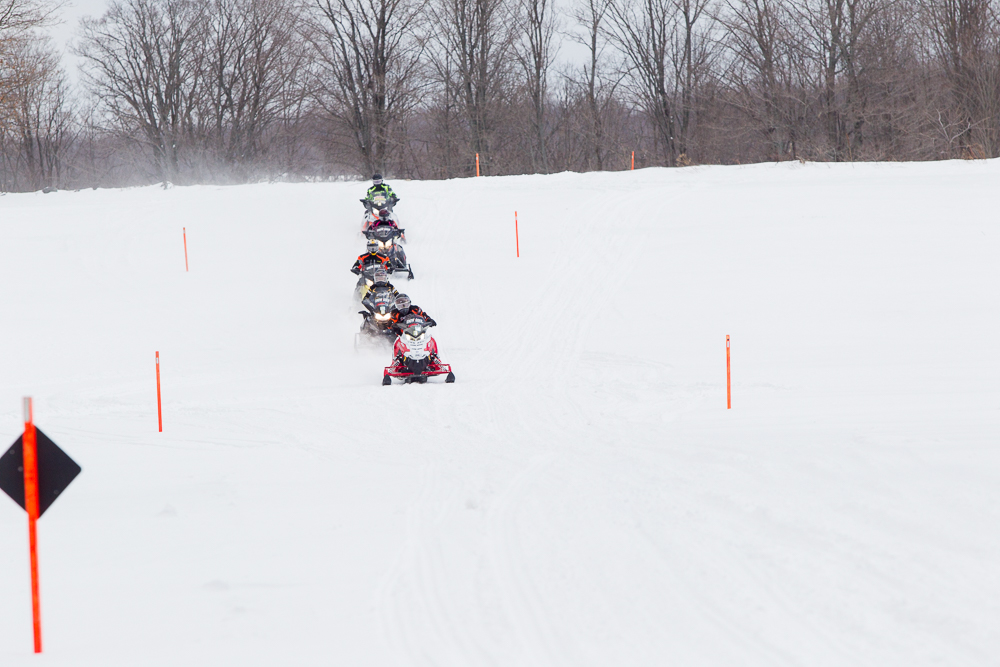Navigational Signs Help Visiting Riders Find Their Way…
Related: Navigating in Heavy Snow
Over my sledding years, I’ve visited many different trail systems and given a lot of thought to snowmobile trail signs. I’ve seen many best practices on the snow. And also witnessed some really poor signage. I’ve come to some conclusions and here they are…
Why We Need Good Snowmobile Trail Signs
Throughout the primary trail riding provinces and states, most snowmobilers typically engage in what’s called “destination riding”. Simply put, this means that we set out with a specific location or place in mind to either go to or visit.
For day rides, it’s usually a lunch destination, likely part of a loop back to our departure location. For multi day rides, destinations range from one main stopping or turnaround point to several other locales along the way.
Navigation Tools
Whatever the case, snowmobilers rely on an array of navigation tools to help get us there. Tools such as paper maps, trail apps, GPS devices and online trail guides. But nothing is more important for reaching our destination than snowmobile trail signs. And they can be a bit of a crapshoot.
First, I should clarify that this article focuses on navigational signage, such as trail numbers, map boards and town-ahead signs. It’s not about traffic and safety signs like STOP, STOP AHEAD or corner arrows. As important as they are, that’s another whole discussion, and you can find out more here.
Purpose of Good Navigation Signs
Ideally, navigational snowmobile trail signs are intended to provide riders with ease of travel, reassurance and confidence. And to help us stay on the trail. To accomplish this, they should serve three main purposes. One, to keep us on route. Two, to guide us in the proper direction. And three, to help us know where we are. These signs should never be confusing, misleading or missing.
Barriers to Good Navigation Signage
Signing For Locals. Not Visitors
Unfortunately, this is not always the case. Often, it comes down to human nature. Well-meaning club volunteers sign their trails as locals who are generally familiar with the area, not as visitors who’ve never been there before.
This is a natural tendency. Why? Because we see things that are already familiar to us with very different eyes than does someone seeing it for the first time. This makes it a considerable challenge for locals to put up all the signs that visitors really need for hassle-free self-navigation.
Signage Guidelines
There are also other barriers to the placement of good snowmobile trail signs. One is insufficient financial resources. Another is that some jurisdictions have inadequate or unadhered to signage guidelines for club volunteers to follow. Or none at all.
Such guidelines help ensure all sign installers understand that they’re signing for visitors. Also, how to do the installation job to achieve overall uniformity and consistency.
Guidelines should address things like sign size, shape, height, font and colour. This way, all signs look the same from area to area, rather than a confusing array of various club interpretations. Meanwhile, snowmobile trail signs should be installed consistently on at least a regional basis. They should not change in look from one club boundary to the next or worse, from trail to trail.
Other Barriers
Damage
 But even if all of this is accomplished, then along come foul weather and roaming animals cause signage problems. To say nothing of the fools who run signs down, steal them or shoot them full of holes.
But even if all of this is accomplished, then along come foul weather and roaming animals cause signage problems. To say nothing of the fools who run signs down, steal them or shoot them full of holes.
Finite Resources
Plus, let’s not lose sight of the fact that the numbers of signs needed to get the job done properly on trails is huge. Human resources to put them up (and in many cases, take them down again at winter’s end) are limited. Volunteers properly trained in sign installation are also insufficient.
Inertia
There’s also another human tendency at play with snowmobile trail signs. It’s something like inertia. It’s the propensity to establish a certain way of doing something, then repeating it over and over again without question or review.
This happens all too often with snowmobile trail signs. The same volunteers put the same signs up in same places every season. This approach works most of the time. And has the considerable advantages of familiarity and efficiency.
But it also can mean that sign location, positioning or need doesn’t take into account new trail factors and changes. Or maybe the original location wasn’t the best in the first place and needs to be moved.
Clues For Inertia
I’ve snowmobiled in several regions where I see this happening. Often, one clue is old, faded or out of date signs still being used. Another clue is the same signage mistakes being repeated every year. There was even one situation where a town name sign continued to reappear long after its trail access disappeared.
So there’s no doubt that generally, snowmobile trail signs are a daunting task. And full kudos to the club volunteers committed to getting the job done season after season. Their efforts make organized trail riding a much better and more comfortable experience.
Signs Over Grooming
Yet we also know that snowmobile trail signs can make or break both a sledding getaway and a rider’s experience. So much so, that after years of trail riding I’ve concluded that good signage is even more important than grooming. Think about it. Without proper snowmobile trail signs, you can quickly get turned around or lost, regardless of how smooth the trail is. But if a trail is rough and well signed, you know where you’re going. Even if it will take a little longer to get there.
Yes, I’ll always prefer the comfort, confidence and reassurance that good snowmobile trail signs provide. Besides, I’ve never run out of gas because of a rough trail. But I’ve come way too close when poor signage led me way off course!
Most Important Navigational Snowmobile Trail Signs
All that having been said, let’s take a quick look from a snowmobiler’s perspective at what I think are the most important navigation snowmobile trail signs. See of you agree…
Trail Number Signs
For me, trail numbers top the list. And notice I said numbers, not names. Trails with names are too hard for visitors to see, read and remember. It’s important that a number designation is short and large enough to read and remember easily. And that it matches what’s on the other available navigation tools. As should the sign colour, shape and template.
Any information that’s superfluous from a rider perspective, such as a club letter or logo should be avoided. Why? Because it can be unnecessarily confusing for visiting riders. Especially if this extraneous info changes on the snow as the trail goes from one club to another. Clubs who want recognition for their trails would be better served to place “Welcome to” and “You are Now Leaving” signs at the points where their trails begin and end.
Instead, I’ve experienced several instances where the actual trail number has changed mid-trail. Or where the sign configuration or colour alters from one club to another. Or is different from the standard template. And recently, I ran into a situation where the number on the snow, on the print map and on the trail app was each different. How confusing do you think that was?
Trail Number Sign At Intersections
Because trail numbers are so important, it’s a given that the placement of trail number signs is equally critical. Every intersection needs to be crystal clear about where the trail I’m following goes. Or where the new trails I need to follow starts.
First, that means every intersection needs to show all the trail numbers that connect at that junction. Second, it also means that these numbers should be clearly visible. And placed to leave no doubt where each meeting trail goes from that intersection.
For example, I love the way some clubs install trail numbers at the actual intersection. Then go one step farther, by placing a reassurance trail number sign 50’ or so down the proper trail. This way, even if I do somehow make a wrong turn at the intersection, I know immediately to choose again.
Intersection Ahead Signs
Third, I think it’s also necessary for every intersection to be preceded by an “intersection ahead” warning sign. This way, riders are prepared to watch for a possible change in their route ahead. To say nothing that it’s safer for everyone coming from all directions to know that there’s an intersection coming up.
As far as number signs on the actual trail, it’s good for reassurance purposes. But if I’m confident that I’ll be properly directed at every intersection, I don’t need number signs on the trail itself as frequently.
Map Boards
Further to trail intersections, I’m always pleased to see map boards at main intersections. They can help re-orient our group or reconfirm our route in a broader context. But frankly, they are only truly helpful if they have “You Are Here” markers to let us know where we are. Otherwise, we’re just guessing.
Another way of achieving “You Are Here” certainty, with or without the presence of a map board, is by intersection numbers. Just like you see on major highways. In the few places I’ve seen these in place, both on the snow at the intersection and on the print map and trail app, they have been very helpful.
Name Signs
Second on my list of most important navigational snowmobile trail signs are name signs. These fall into two main groupings: town names and names of service providers.
Town Name Signs
I’d argue that town name signs are primarily for local/regional riders. These snowmobilers are already familiar with what towns are in the area. And generally, what direction they’re in. But visiting snowmobilers aren’t. They may not even have heard of the communities before. Or in the case of Quebec, can’t easily comprehend their French names and so many “Saint’s” this or that!
So listing a bunch of towns on signs with pointing arrows and distances (sometimes, sometimes not), isn’t as good as trail numbers for visitor navigation purposes. But it is helpful for imparting information about where the next services or assistance may be. And it’s always helpful if there’s a name sign that actually lets you know you’ve arrived at the town you’re looking for!
This assumes of course, that once I get close to the next town, there’s a sign on the trail that lets me know I’ve arrived.
Many’s the time I’ve seen several town signs farther out on the trail. But then, no sign indicating this is it. Yet I bet the main road through town has a “Welcome to Town A” sign announcing its presence to visitors. Snowmobilers need to know that too! Sometimes, especially when the community isn’t directly on the trail, I’ve passed the town entirely before I realized that was it!
Service Name Signs
It’s also important for a town to have on trail signs for services so I know where to turn off to get fuel, food, sled service or lodging. Absent these signs, touring snowmobilers are left to guess (and hope) that there are services available. And that they can be found without undue pavement running. Or riding on streets where travelling by sled is illegal.
As a touring rider, I’ve found that service name signs are more important than town names signs. Frankly, I don’t really care as much about what town I’m at as I do about finding a hotel, gas station or lunch stop. So signboards or signposts displaying service name signs, direction and distance make my day. But my pet peeve is that all too often, the closer I get to the service, the fewer signs there are. It’s very frustrating for service name signs to stop just when you’re almost there!
Stakes Galore
Every fall, many snowmobile clubs install thousands of field and lake stakes. While they are not exactly signs per se, they can be equally important navigation aids. These usually bright and reflective pickets mark the easiest and safest route across an unfamiliar land or water route. Of course, they also serve to enhance safety, keep riders on the trail, and act as guides from groomer operators.
For touring snowmobilers, stakes are especially valuable when crossing large open areas where it would otherwise be easy to stray off course or get lost. Particularly in white out or blizzard conditions during snow storms or squalls. Or after dark.
So next to trail number and names signs, I consider stakes a very valuable asset. And whenever I see tracks where some uncaring snowmobiler has wandered outside the stakes, or worse, run them down, I’m very upset. I know that such negligent behaviour often results in trail closures. And having the trail re-routed onto a public road only exacerbates my anger.
Road Running Signs
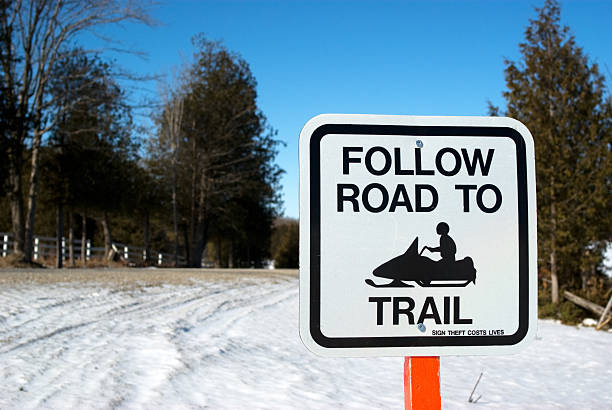
But road running is increasingly a fact of life. Especially in many agricultural areas. So if I’m going to get dumped out on or beside a road, I need a sign there with an arrow, saying “Follow Road to Trail.” This needs to be followed by arrows along the way. And definitely at every intersection, to let me know I’m still going the right way. And haven’t missed the trail.
Ideally in instances where that road running is some distance, that first sign would also tell me how far to follow this road to the next trail. And before I get to it, I’d appreciate a sign warning that the turn off back onto the real trail is coming up. And whether it’s a right or left turn. This is particularly necessary because all too often, snowploughs have piled snow banks across the trail entrance, making it difficult to find.
My Last Word
I know it’s not a perfect world. And that snowmobilers can’t expect (or afford) highway quality signage on the trails. In fact, I’ve spotted some signs that are just plain hilarious!
That aside, I know that club volunteers are largely responsible for snowmobile trail signs. And that in most jurisdictions, there is no legal requirement to install navigational snowmobile trail signs.
But I also know how much better a ride I have in areas that do a good job with snowmobile trail signs. And as a visiting snowmobiler, that makes me want to come back for more. It also makes me wish that the snowmobile trail signs could be as good on every other trail I ride.
Finally, I know that the only way to achieve top class snowmobile trail signs is for more snowmobilers to volunteer for signage installation. After all, clubs never have enough assistance and who is better qualified to help with signage? Touring riders can evaluate snowmobile trail signs with a fresh eye and knowledge of what works elsewhere. So why not surprise your club this fall by signing up for signing? Maybe together we can make navigating our winter wonderland even more enjoyable!
The tips and advice in this blog are the opinions of the author, may not work in every situation and are intended only for the convenience and interest of the reader, who has the personal responsibility to confirm the validity, accuracy and relevancy of this information prior to putting it to their own use.
Like this post? Follow me on Facebook!

